Hello Lovelies!
I have just a quick post today. Take a look at the hair meme below. If you’ve ever experienced this, then you know what I’m talking about, lol. Enjoy and don’t forget to share the humor!
By Renee Price
By Renee Price
Hello Lovelies,
I’m all about dispelling hair care myths, and today I’d like to dispel a huge one that will save the strands of tons of women. If there is one tool that I could remove from the beauty kit of most women, it would have to be the hair brush. Many women think hair brushes are a must because brushing the hair distributes natural oils from the scalp along the length of the hair, making it shiny, but this couldn’t be further from the truth. If you don’t have the hair type where natural oils don’t naturally reach the ends of your hair, daily brushing won’t make it happen either. Hair brushes are so unnecessary and at worse extremely damaging.
The traditional hair brush is constructed from hard bristles that aren’t uniform in nature. If you look at a traditional boar-bristle brush, you’ll see that some bristles are short, some are long, and the bristles are generally not all the same length. This is the perfect recipe for hair damage.
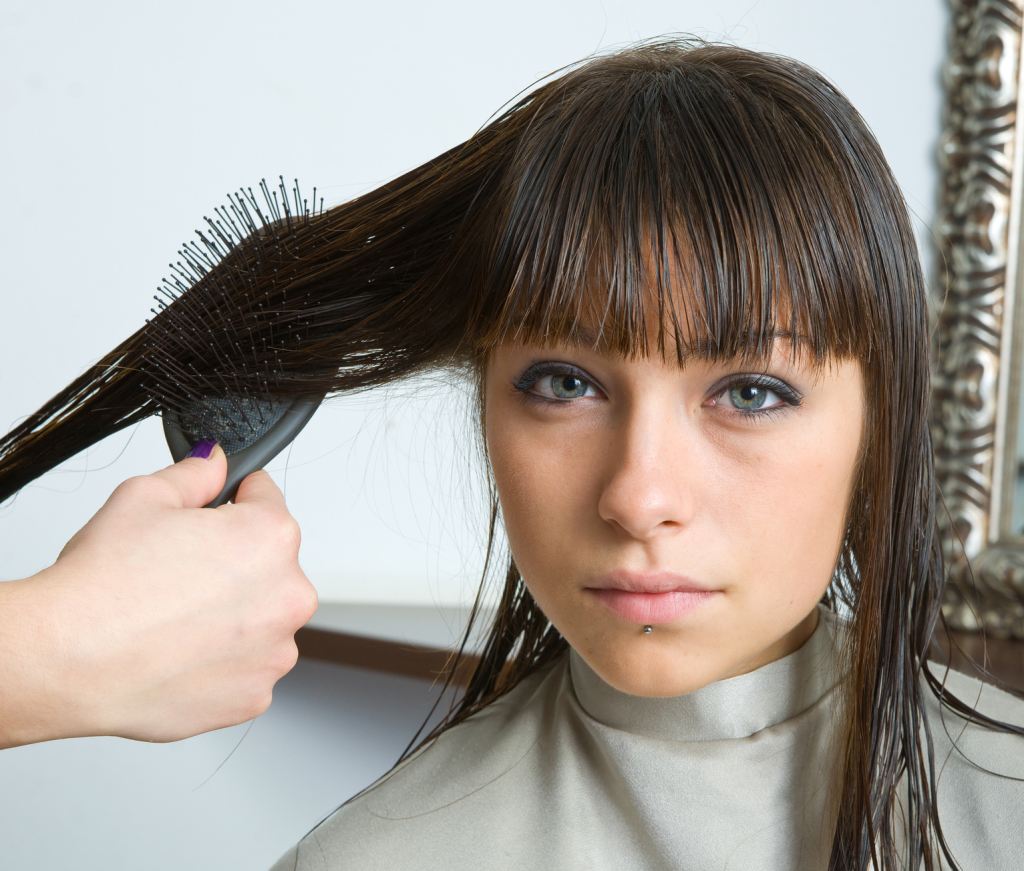
Hair brushes are one of the most damaging hair styling tools.
The simple motion of brushing places undue friction on the hair that leads to frizz, an actual loss of moisture and shine, and damage to the hair’s cuticle layer. Anytime you style your hair with a hair tool that has bristles or teeth that are spaced very closely together, you’re introducing the opportunity to create snags and pull out your hair. Even combs with very fine teeth can damage your hair strands, so imagine the mechanical damage hundreds of little bristles can cause to your delicate strands.
If you have fine hair and hair that is susceptible to split ends, you should eliminate brushes all together. However, if you have thicker hair strands, I understand that brushing can be a timesaver and styling godsend for your hair. If you must use a hair brush, stick to brushes that have widely spaced bristles and bristles that are even in length. If you must incorporate brushes into your styling routine, make brushing the last part of your styling regimen, and never brush your hair while it’s wet or even slightly damp.
By Renee Price
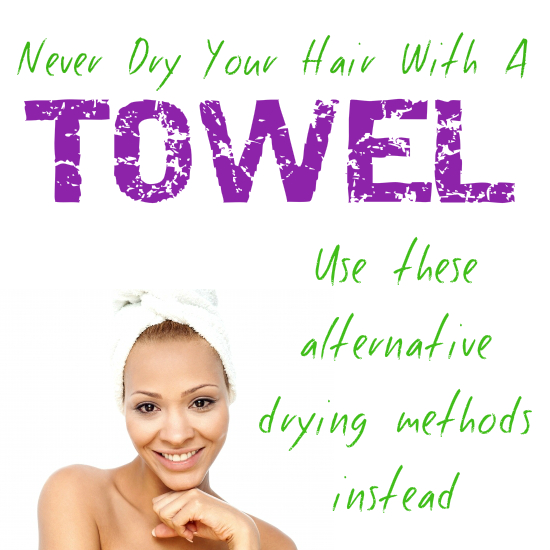
Hello Lovelies!
In the past, when I finished washing and cleansing my hair, the first thing I did once I stepped out of the shower was reach for a regular bath towel to dry my hair. BIG MISTAKE! Traditional bath towels are rough enough to actually lift the hair’s cuticle layer. The fibers on terry cloth towels act like little hooks and clasps that are small enough to catch the scales in the hair’s cuticle layer and separate them from the hair’s cortex. Drying your hair with a traditional towel will leave your tresses overly dried, frizzy, and broken. So opt for these alternative drying methods that will leave your hair smooth and well moisturized after your next cleansing session.
As with most people, I associate microfiber towels with hours of cleaning and tidying up the house, but who knew that these heavy-duty cleaning towels are a great alternative to traditional towels for drying your hair. Microfiber towels are made of very fine and densely packed fibers that makes for a much smoother drying surface for our hair. Microfiber towels also absorb just the right amount of moisture from the hair, unlike terry cloth towels that absorb too much moisture from the hair, leaving it dry and susceptible to breakage.
Aquises’ Mimi Diva Dryer Hair Towel is a favorite among those who transition from traditional terry cloth towels to dry their hair to alternative hair drying methods. The Diva Dryer Hair Towel is super absorbent and claims to dry your hair in half the time. The DevaCurl Deva Towel is another microfiber hair drying towel that is popular among curly haired gals because it’s smooth surface dries the hair without creating frizz and makes curls pop.
A microfiber towel is nice and convenient to have on hand, but if you don’t have one, an old t-shirt will do. Yes, an old t-shirt. Cotton t-shirts are soft, ultra absorbent, and perfect for drying freshly washed hair. If you have curly hair, drying your hair with a t-shirt will help your curls clump and form perfect and frizz-free ringlets. This technique, formerly known as plopping or plunking, involves bending over and flipping your head upside down into a t-shirt to scrunch the curls of your hair, and carefully folding up the t-shirt rolling up the t-shirt and securing it to dry the hair. Plopping/plunking helps curls form much more easily, and for some people, it helps to elongate the curls and mitigate shrinkage as the hair drys.
If a microfiber towel or t-shirt isn’t handy and you’re in a pinch, paper towel is a great alternative for drying your hair. Hey, anything is better than a towel! I will note that lint-free paper towels are what you want to use because you’ll most certainly have to re-wash your hair if you use paper towels that lint and peel. Viva paper towels are my favorite brand for drying the hair. They’re smooth, soft, and they really absorb a lot of water. To dry your hair with paper towel, simply scrunch, squeeze, and blot excess moisture from your hair, never rub or roughly tousle your strands to remove water.
photo credit: stockimages
By Renee Price
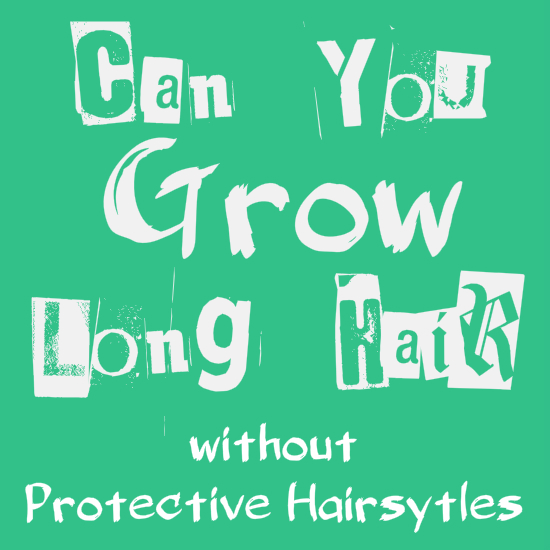
Hello Lovelies!
Ariella K. has a great question about protective styles. Ariella wants to know:
Love your website. I’m a bit resistent about this protective styling thing. I mean I know it makes sense, but I just don’t know about wearing buns and other styles like it all the time. I’m just so used to wearing my hair down everyday, and I’d much more prefer it. So is it possible to grow my hair long and not get split ends without wearing protective hairstyles?
Hello, Ariella! Thank you so much for your question. For those of you who don’t know, protective hairstyles are hairstyles that allow you to protect the ends of your hair and go without re-styling your hair for days at a time. Protective hairstyles are conducive to growing long hair because your hair is retains moisture better, it’s free from damaging hair care practices, and the most vulnerable parts of your hair, the ends, have the utmost protection. While protective hairstyles are the best styling option for ladies who want to grow out their hair, they aren’t the only styling option that will allow you to reach your long hair goals.
If protective hairstyles aren’t your thing, low manipulation hairstyles are an alternative styling option. Unlike protective hairstyles, low manipulation hairstyles, don’t involve tucking away the ends of the hair. Low manipulation hairstyles also don’t last as long as protective hairstyles without the need to re-style or tidy up the hair to make it look presentable. However, low manipulation hairstyles are simple enough where manipulation to your hair is kept to a minimum and will not cause unnecessary damage to your hair.
So to answer your question, you absolutely can grow your hair long without protective hairstyles. I just recommend them because they’re a foolproof way to get guaranteed longer hair. If your hair is up, protected, and has virtually no chances of sustaining damage, the only thing it can do is grow. Depending on your hair type, you may be able to get away with not wearing any protective hairstyles at all and still reach your long hair goals. Straighter hair types may have no problem retaining length without protective hairstyles because straighter hair strands tend to have a stronger cuticle layer and retain moisture better. Curlier and highly textured hair types may have more difficulty retaining length without the aid of protective hairstyles because curlier hair tends to be drier and more prone to breakage when it’s worn in it’s natural, unaltered state. Protective hairstyles help preserve the delicate hair strands of curlier hair types and place less friction on curly and highly textured hair strands.
You never stated your hair type Ariella, so I don’t know for sure, but if you have curlier hair, then I would absolutely suggest that you give protective hairstyles a try. Otherwise, if you have a straighter hair type, experiment with low manipulation hairstyles for a few months and see if they aid or hinder your long hair goals and adjust your hair care regimen accordingly. Good luck on your long hair journey!
By Renee Price
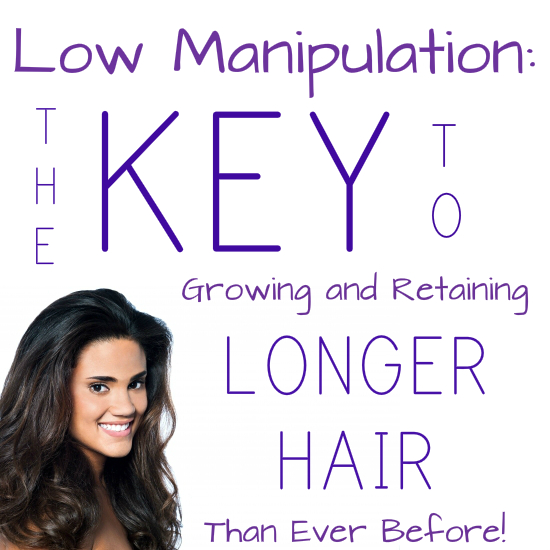
Hello Lovelies!
Our hair is very delicate. That statement sounds so simple, but it’s very true, and it’s something that has taken me a long time to learn and accept. How many of us have yanked and snatched through our hair to quickly complete a style? How many of us blow dry and flat iron our hair day in and day out? How many of us wash our hair every.single.day? How many of us twirl our hair endlessly and mindlessly with little thought to how it affects our hair? These are all bad hair care practices that dramatically increase the opportunities for us to damage our hair. If you’re damaging your hair as fast as it grows, you’ll never see any meaningful amount of retention in length. The number one way to reduce your hair’s potential to break is to adopt a low manipulation hair care regimen.
Low manipulation is a hair care practice where handling, styling, and maintenance of the hair is kept to a minimum. How you handle your hair on a daily basis has real effects on how well your hair retains length. Everytime you touch your hair, the wind blows through your tresses, or your hair comes into contact with any object, the hair strand sustains microscopic forms of wear and tear that adds up over time. Your hair doesn’t need much help from you to split and break, so imagine how much faster it sustains damage when you handle it frequently and without much care. Now imagine how much you can slow down damage when you keep manipulation and handling of your hair very low.
If you want your hair to not only be long, but also be long, healthy, and as lustrous as possible, let your hair be and leave it alone as much as you can. Refraining from unnecessary styling, touching, and twirling and simply letting your hair be will give it the opportunity to do what it was designed to do with no interruptions, grow!
Now I believe low manipulation is relative, and what one person considers low manipulation for their hair may be different for another person’s hair. However, I also believe that a low manipulation approach to hair care is vitally important the curlier your hair texture. The tendency for curlier hair textures to be drier, easier to tangle, and more prone to breakage makes regular makes everyday handling of the hair harmful to the hair strand over time. A gentle and patient touch is a must when handling curlier hair textures, and low manipulation is the perfect approach to handling curly and highly textured hair types.
Now when I suggest only doing what’s needed for your hair, this includes cleansing and conditioning. When it comes to how you care for your hair, you should take a low manipulation approach at every step in your hair care regimen. How can you incorporate low manipulation into your cleansing and conditioning regimen? Well for one, no matter your hair type, it’s usually not a good idea to wash your hair everyday. Simply refraining from washing your hair everyday is one way to take a low manipulation approach to washing your hair. Another example is only shampooing your scalp, the portion of your hair that needs the most cleansing, and never piling your hair on top of your head while shampooing to prevent tangles. Another trick is using dry shampoo or baby powder on your scalp to extend the amount of time you can go without shampooing and manipulating your hair.
If you have curly or highly textured hair, you can really reduce the manipulation and handling of your hair during your cleansing and conditioning sessions by shampooing and conditioning your hair in sections. Instead of washing your curly hair while it’s loose and more susceptible to tangles, braid or twist your hair into two or more sections and cleanse and condition your scalp while your hair while isbraided or twisted to keep handling, friction to your hair strands, and breakage to a minimum.
The ways that you can incorporate low manipulation into your hair styling regimen are practically endless. From how you dry your hair to the tools you use on your hair, there is always a low manipulation and less damaging alternative to how you usually style your hair.
Personally, I think blow drying is how most women sustain significant damage to their hair. Many of us don’t realize how damaging this common hair practice is to our delicate hair strands. Many of us also don’t realize that there are several alternatives to using a blow dryer to dry our hair and there are ways to make blow drying less damaging. Air drying your hair is one way to make blow drying less damaging. Air drying simply means allowing your hair to dry on it’s own without the use of a blow dryer. Allowing your hair to air dry just 50% before blow drying it will reduce the amount of time you need to use the blow dryer to completely dry your hair and thus reduce the amount of time you need to manipulate your hair.
Another alternative to using a blow dryer is to style your hair while it’s wet and letting it dry on it’s own. You’ll notice a significant difference in the health and condition of your hair if you cut out blow dryers all together. Wet styling enables you to keep manipulation of your hair extremely low because you no longer have to submit your hair to the damaging heat and high manipulation required by blow drying, and wet styles tend to last much longer than hairstyles installed on dry hair.
As you look for more ways to make your hair care regimen low manipulation, the tools you use to style your hair may also change. I think the best styling tool for a low manipulation hair care regimen is your own hands. Yes, your hands. Our hands can maneuver our hair in ways that even a comb and a brush can’t, and you can feel tangles and knots in your hair with your own hands before a comb or a brush can detect them. Your hands are also the best way to remove tangles and matting because a comb or a brush may actually make tangles worse if you don’t use it properly. Your hands are the safest bet when it comes to styling because your hands will put much less pressure and tension on your delicate hair strands than other styling tools. My only advice is to make sure your nails are smooth and free of rough edges to prevent snags and snarls while handling your hair.
If you decide to incorporate other styling tools, such as a comb, into your hair styling regimen, I suggest going for a seamless, detangling comb to keep manipulation of your hair to a minimum. The more teeth and seams a comb has, the more opportunities it has to break and damage your hair, but a seamless, detangling comb is specially designed to detangle even the thickest and highly textured strands of hair. I suggest that you avoid brushes all together if you want to maintain a low manipulation hair care regimen.
Low manipulation hairstyles require minimal handling to install and maintain. If you have to re-style your hair everyday to make it look nice and presentable, then your hairstyle requires too much manipulation. A low manipulation hairstyle should enable you to go at least a couple of days without having to even touch your hair. I like low manipulation hairstyles as well because they’ll also help you from obsessing over your length and how fast your hair is or isn’t growing and allow you to get on with more important things in life.
Protective hairstyles such as buns, braids, and twists are all great low manipulation styles, but you don’t always have to wear protective styles to keep manipulation of your hair to a minimum. There are also hairstyles that are known as “low manipulation hairstyles” in the hair care world that will allow you to wear your hair down, but keep handling of your hair to a minimum. These hairstyles aren’t as protective of the ends of the hair as protective styles, but they’re much less damaging than most other hairstyles that require daily maintenance and upkeep. Ponytails, roller sets, braid outs/twist outs, and heat-free curls are all examples of low manipulation hairstyles that can be worn for a few days without the need to re-style or tidy up your hair. Protective hairstyles may not be appealing to everyone, so low manipulation hairstyles are a great alternative.
So there you have it! Every aspect of your hair care regimen can be overhauled to provide for a low manipulation approach to how you care for your hair. When you start to do less to your hair in terms of handling it everyday, you’ll start to notice a boost in the health and length of your hair. If you want to grow your hair out longer than you ever have before, trust me when I say that less is more.
photo credit: stockimages
By Renee Price
Hello Lovelies!
Think long hair is only for younger gals? Think again! These 9 fabulous female celebrities break away from tradition and show that women can rock beautiful, long locks at virtually any age.
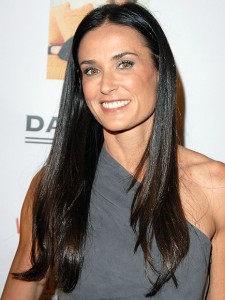 Outside of her G.I. Jane period, we’ve only known Demi Moore to rock her sexy and mysteriously dark, long locks, and we couldn’t imagine this flawless beauty any other way.
Outside of her G.I. Jane period, we’ve only known Demi Moore to rock her sexy and mysteriously dark, long locks, and we couldn’t imagine this flawless beauty any other way.
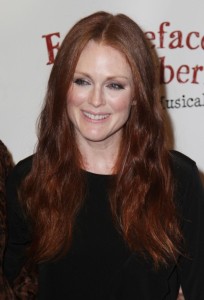 Julianne Moore has worn her hair long for as long as we’ve known this graceful beauty, but the reason she opts for long hair instead of short hair may surprise you. The actress’s hair is naturally wavy and thick, so the weight of her lengthy locks is the only thing that keeps her hair smooth and neat.
Julianne Moore has worn her hair long for as long as we’ve known this graceful beauty, but the reason she opts for long hair instead of short hair may surprise you. The actress’s hair is naturally wavy and thick, so the weight of her lengthy locks is the only thing that keeps her hair smooth and neat.
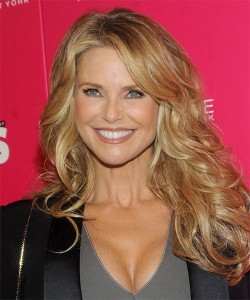 As a model from an era where big hair gave the illusion of a smaller body, long, voluminous hair has become just as trademark as Christie’s megawatt smile. Christie Brinkley loves long hair so much, she recently launched her own wig line to give other women the long, lustrous hair they desire.
As a model from an era where big hair gave the illusion of a smaller body, long, voluminous hair has become just as trademark as Christie’s megawatt smile. Christie Brinkley loves long hair so much, she recently launched her own wig line to give other women the long, lustrous hair they desire.
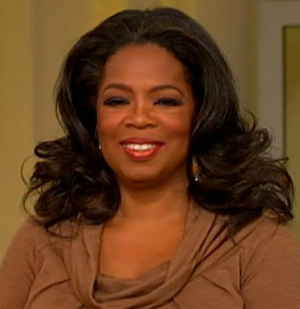 Oprah Winfrey’s perfectly coiffed hair has gone through many style changes throughout the years, but in 2009 when comedian Chris Rock discovered Oprah’s long and thick locks were all her own, his shock and surprise was echoed by millions of people around the world.
Oprah Winfrey’s perfectly coiffed hair has gone through many style changes throughout the years, but in 2009 when comedian Chris Rock discovered Oprah’s long and thick locks were all her own, his shock and surprise was echoed by millions of people around the world.
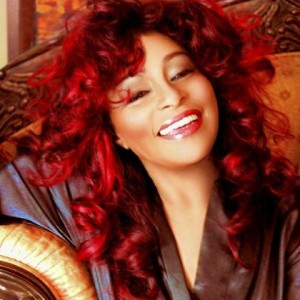 When Chaka Khan wasn’t noticed for her big voice, her big, beautiful hair stole the spotlight. The beautiful songstress has always rocked her hair long, big, and natural, and age hasn’t pressured Chaka to abandon her signature hairstyle.
When Chaka Khan wasn’t noticed for her big voice, her big, beautiful hair stole the spotlight. The beautiful songstress has always rocked her hair long, big, and natural, and age hasn’t pressured Chaka to abandon her signature hairstyle.
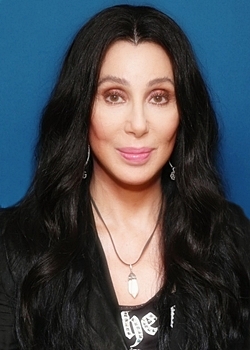
Almost as iconic as those beautiful big eyes, Cher’s hair has spawned many a hairstyle trends for decades. Girls were literally ironing their hair with clothing irons to mimic Cher’s chic and dark locks, but little did those girls know, Cher often wore and continues to wear wigs to prevent damage and breakage to her real hair.
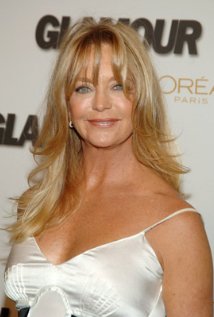
Goldie Hawn first emerged as an actress with a short pixie cut on the television show Rowan and Martin’s Laugh-In, but longer lengths are perfectly suited for this buxom blonde’s beautiful tresses.
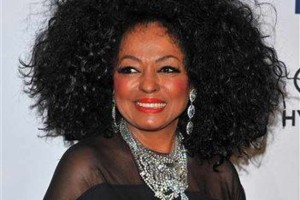
If anyone is the Queen of big hair, it has to be the incomparable Diana Ross. The Boss has sported a variety of hairstyles throughout her 50+ year reign in the music industry and Hollywood, but it’s her big, beautiful mane that she is most recognized for.
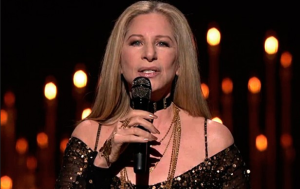
From short bobs to beach blonde highlights, Barbra Streisand’s been pushing the limits with her hair since she’s been a teenager, but it’s her longer, shiny locks that really seem to suit her best in her later years.
By Renee Price
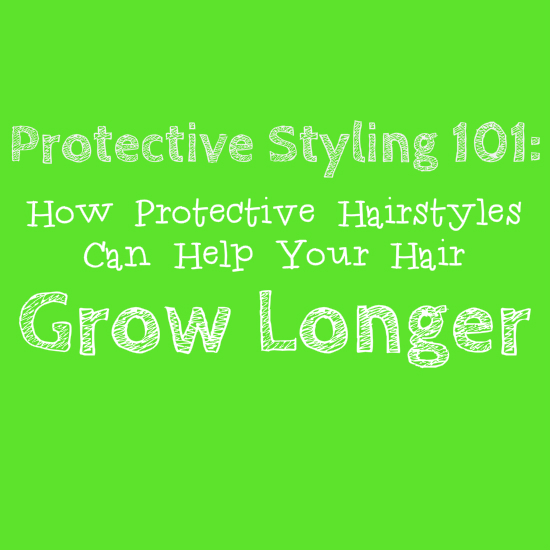
Hello Lovelies!
In the quest for long hair, many ladies come to realize it’s not how fast you can make your hair grow, but it’s how much you can keep the hair you do grow. The proper term for this “realization” is length retention. You can grow 6 inches of hair a year, but if you’re frying, dyeing, and damaging your hair on a frequent basis, you won’t retain much if any of those 6 inches of hair you’ve grown. The key to retaining more length and reaching your long hair goals is reducing the opportunities your hair has to sustain damage, split, and break off. Most hair breakage is caused by the things we do to our hair. From curling to bleaching, most human hair breaks as a result of the ways we choose to style it, so if you want to reach your goals of growing long hair, protective styling should be a mainstay in your hair care regimen.
Protective hairstyles protect the ends of the hair, the oldest and most vulnerable portion of the hair strand, and reduces the frequency the hair needs to be styled and manipulated. Protective hairstyles can range from a simple bun to elaborate updos, but as long as the hair is up and off of the shoulders and the ends of the hair are tucked away, it pretty much counts as a protective style. Protective styles are low-maintenance, simple, and easy hairstyles that ladies who wish to grow long hair can wear for days at a time (some hair types can wear protective styles for week or months at a time) without having to restyle their hair.
In my opinion, a protective hairstyle is also a hairstyle that doesn’t require the use of direct heat, such as a curling iron or hand-held drier, with the exception of braided hairstyles for curlier hair textures. Using these styling tools to create a protective style is counterproductive. The purpose of a protective hairstyle is to help your hair retain moisture and remove styling tools and styling methods from your hair care regimen that could lead to extensive damage.
Protective hairstyles won’t make your hair grow faster because nothing will make your hair grow faster. What protective styles do is basically saves us from ourselves; let me explain. Barring illness or some other non-controllable factor, the main reason most of us don’t retain length and grow long hair is because our hair is breaking off as fast as it grows. Everytime you even touch your hair, you have the potential to cause damage to your tresses. When you wear a hairstyle that requires you to physically handle your hair two to three times a week at most, you drastically reduce the opportunities you have to damage your hair.
Protective styles also facilitate growth by keep the ends of your hair moist. Have you ever taken a bun down and noticed that the ends of your hair were extremely soft and moisturized? That’s because your hair was tucked away and able to keep most of it’s moisture that would otherwise be lost to the air or soaked up by your clothing as your hair rests against your back. Well moisturized hair is another key to retaining length and growing long hair because hair that is moist is much more flexible and less likely to split or break. Every moment that the ends of your hair are exposed, moisture is slowly leaving your hair, but keeping those ends tucked away and hidden will help the oldest portion of your hair keep much needed moisture for longer periods of time.
The power of protective, low-manipulation hairstyles are most evident among children. I’m sure most of us would agree that very few mothers are styling their little girls’ hair with heat, hair dyes, and elaborate hairstyles that call for vigorous brushing and combing. Most little girls wear very simple and easy to maintain hairstyles that require very little manipulation of the hair. So, a young girl’s hair has the optimal chance to retain length and grow long because a young girl’s hair isn’t exposed to damaging hairstyling practices or damaging hair tools. Us older gals can experience the same success in terms of our long hair goals by going back to the simplicity and ease of hairstyles from our younger years.
So if you want to retain more length than you ever have, I urge you to give protective styles a try. You don’t have to wear these styles everyday, but incorporating protective hairstyles into your hair care regimen will help you fight hair breakage and help you make some serious gains in terms of length retention.
By Renee Price
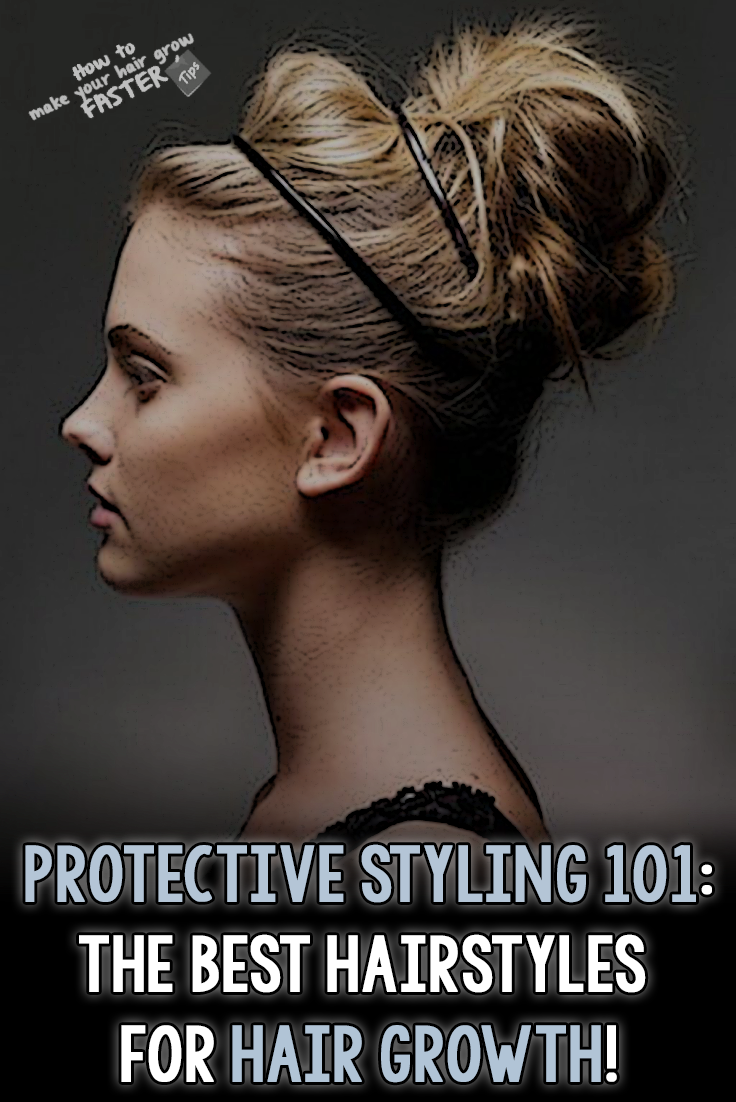
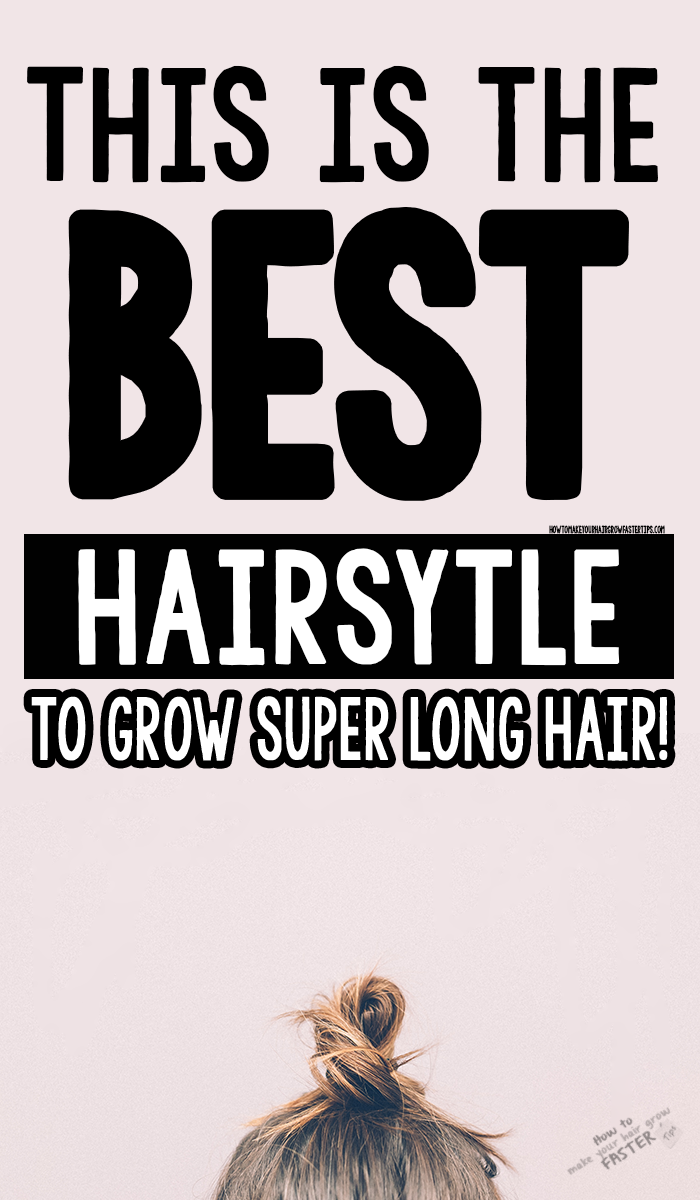
Hello Lovelies!
Many of us can recall the time when styling our hair was totally off limits and “mommy’s job,” and like me, I’m sure most of you couldn’t wait to grow up and take the reigns over caring for your own hair. Well, when we finally grew older and started experimenting with our hair and hair styling possibilities, too many of us went overboard. From cutting, to coloring, to curling, to flat ironing, to blow drying, and everything in between, many of us have put our hair through so many styles that are stressing and damaging to the hair. Overtime, regular and frequent hair style changes (especially hairstyles that use heat) can be detrimental to the condition of your hair and your long hair goals. If you want your hair to become stronger and gain significant length, incorporating protective styles into your hair care regimen may help you reach your long hair goals faster.
Protective styling means different things to different people, but in the simplest terms, protective hairstyles are hairstyles that require low-manipulation and shield your hair from physical and environmental agitation. So to me, a protective style is a hairstyle that can stay in place for a while without the need to re-style the hair, anywhere from a few days to a couple of months. A protective hairstyle is also a hairstyle that protects the ends of the hair, which is the oldest and most fragile portion of the hair on any person’s head. Now it’s virtually impossible to eliminate all disturbances to the hair, but it is possible to limit them. What protective styling really does is limits the opportunities we have to damage our hair, and it gives our hair a ‘break’ and a chance to grow without disturbances.
Now many people think protective styles have to be boring or plain, but truth be told, protective styling options are wide and varied. No matter your hair type or the length of your hair, there are protective styling options available to you, and they can be as simple or as elaborate as you’d like. As long as the ends of the hair are protected from the elements and the hairstyle you’ve chosen can last for at least a few days without the need to re-style your hair, then it counts as a protective style. Here are the top 6 protective styles for growing longer hair.
From the messy bun to the sock bun, buns are perhaps the easiest and most versatile protective styling option for all hair types. Buns allow you to protect the ends of the hair, and most buns can be worn for a few days before they absolutely need to be taken down and restyled. However, I would note that it’s important to use the proper hair tools to secure your bun in an effort to prevent damage. Opt for hair ties that don’t have metal parts that can snag the hair and cause breakage. Also, try to vary the positions where you place your bun on your head to prevent strain and breakage in one area of the head. For example, if you wear a low bun one week, opt for a high bun the next week, and alternate the bun’s position every week or so you don’t put undue stress on the crown or nape of the head. Also, if you use bobby pins to secure your bun, make sure to vary the position of the pins as well to prevent stress and breakage to the hair.

The french roll is an elegant protective style for special occasions or just simple everyday wear, and it’s just as classic as the bun; no matter what anyone says, it’ll never go out of style! My mom had a friend who wore a thick and perfectly coiffed french roll everyday for years. As a child, I always wondered how long her hair was, but I never had the gall to ask. However, I was lucky enough to catch her a home one evening after she had taken her hair down, and I was shocked/not so shocked to see that she had waist-length hair. I guess those years of sporting her french roll paid off!
I like the french roll because it’s quick and easy, and it can be done on practically any hair texture. However, similar to buns and chignons, vary the position of the hair pins you use to secure your hair, and don’t pull too tightly on the nape or hairline when you create your french roll to prevent thinning and hair loss to these delicate regions.
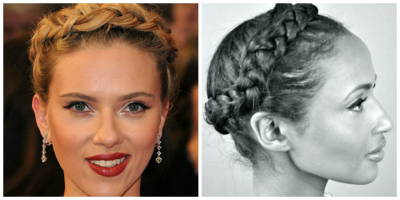
The thing I like about updos is that there is no right or wrong way to do them. With updo hairstyles, you can get as creative as you like when it comes to protecting your hair; and no matter your hair type, the updo hairstyling options out there are virtually endless. One of my favorite protective updos that’ll work on all hair types is the halo braid. It takes a bit of learning to achieve the style, but once you get it down, it’s sure to be an instant styling favorite, and the hairstyle can last for several days without the need to re-style.
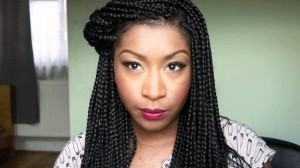
Contrary to what some people may say or think, braids are an excellent protective style for curly and highly-textured hair types. As long as your braids aren’t too tight and don’t place too much tension on the hair, braids are a great protective style because you can go without re-styling your hair for weeks at a time. Ladies with highly textured hair benefit from braids because the style requires no to low manipulation of the hair, which is important for hair types where any amount of friction between the hair strands can be detrimental overtime. If you opt for braids as a protective style, just be sure to keep your braids moist by using a braid spray or homemade moisturizing mix that you apply directly to your braids, and keep your scalp clean and clear from oils and buildup. Check out this awesome box braid styling tutorial from Jennifer Olaleye.

Extensions and hair weave totally gets a bad rap, because when properly applied and cared for, this styling option can help curlier and textured hair types retain length. Hair weaves are a great protective style because they allow the hair to rest and simply grow without interruptions for months at a time. Perhaps the reason why weaves and extensions have a bad reputation for damaging the hair is because they require diligent care, almost as if you were caring for your own hair, perhaps even more so. Most hair weave horror stories happen when the base of the weave, the braids, is too tight and places too much tension on the hair. Also, failure to routinely shampoo and moisturize your real hair underneath a hair weave can be counterproductive if you’re wearing the hairstyle to retain length.
If you decide to go with a hair weave as your protective style, make sure your braids underneath the weave are firm, but not tight. Opt for high-quality, human hair instead of synthetic, and sew the weave to your braids with higher quality, cotton thread instead of synthetic threads that can cut and damage your braids. Shampoo your hair weave every few weeks or so, and follow up with a deep conditioner to keep your real hair pH balanced. Always make sure the braids underneath your weave are properly dried after each cleansing session (this may require you to sit under a hooded dryer or use a handheld drier with a nozzle), and moisturize your braids underneath the weave at least once a week. Now if you have thin hair or hair that is severely damaged, a hair weave may cause more damage to your hair if applied by an inexperienced stylist. Additionally, I don’t see this hair style working for straighter hair types that need more frequent washing and wouldn’t be able to hold braids for too long; it simply wouldn’t be worth the hassle.
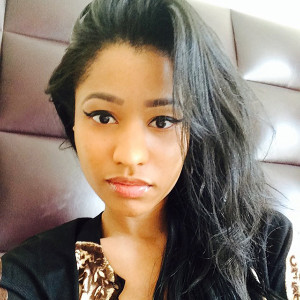
Who doesn’t love Nicki Minaj’s funky and stylish wigs? Well when she decided to shed her popular wigs and wear her natural hair, many people were shocked that she had a full head of hair of her own, but not me, because I know that wigs are a great protective style. Celebrities like Nicki Minaj and Beyonce have to change their hairstyles very often to keep us, their fans, guessing and wanting to copy their every move. However, those frequent hairstyle changes would wreak havoc on their own locks, so many stars opt for wigs instead to protect their own hair from damage. Even Kim Kardashian has taken to sporting wigs as of late, and I’m willing to bet it’s because her constant use of clip-in extensions has thinned and damaged her hair.
If you want to give wigs a try as a protective style, be sure to cover your hair with a satin or silk cap prior to placing the wig to prevent friction-based damage to your real hair underneath. If you have curly or highly textured hair, consider cornrowing or braiding your hair into a beehive so you can wear your wigs without manipulating your own hair. Also, don’t forget to remove your wig every night to give your scalp a chance to breath, and keep up with the regular moisturizing and cleansing portions of your hair care regimen no matter how your hair is styled underneath your wigs.
I will note that wigs can cause damage to the hairline and edges of the hair if improperly placed, so to prevent this from happening use wig liners like this one to protect your hairline and skin.
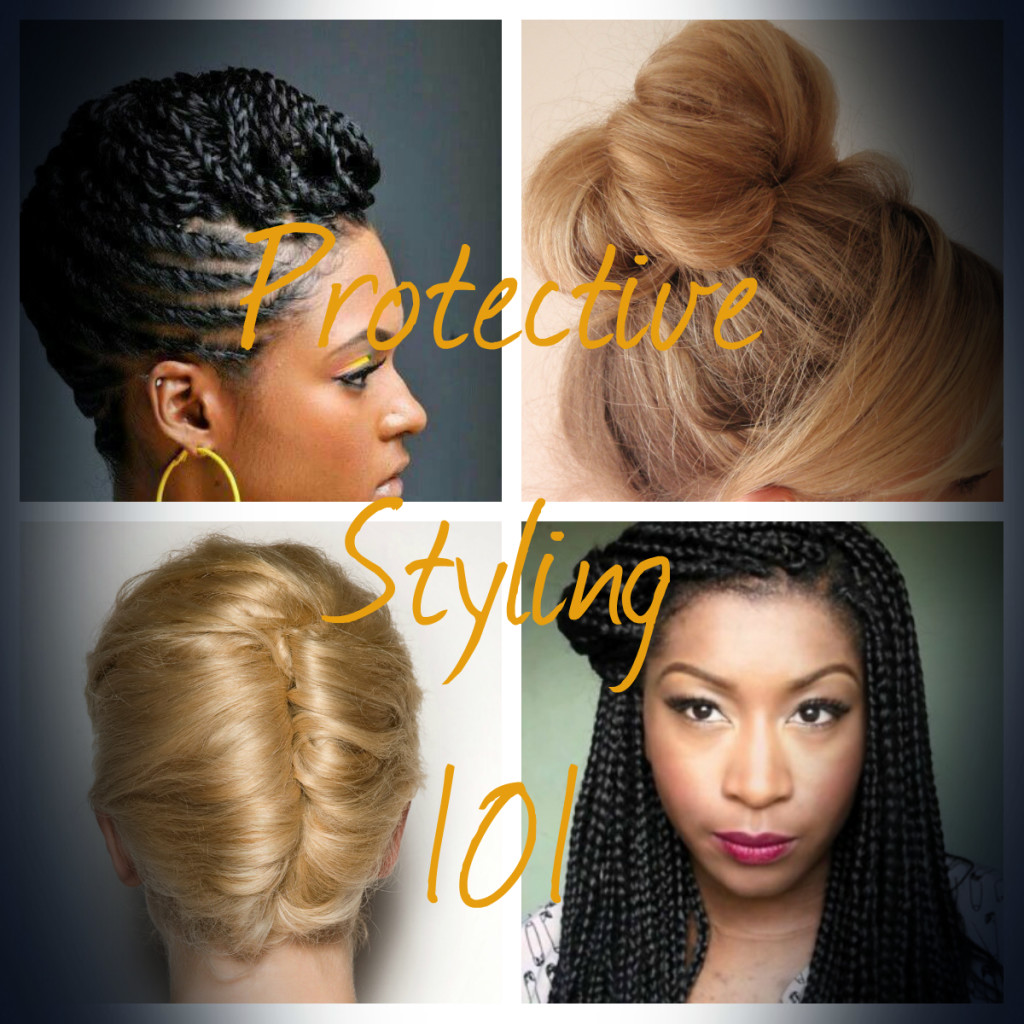
Photo & Video Credit: Lesleigh @ Pearls on a String | fevenandhelena | Jennifer Olaleye | Yipski @ Flickr | Nicki Minaj Instagram
By Renee Price
Hello lovelies,
When you’re out this summer enjoying family, friends, and most of all the warm weather, I’m sure your hair will be the last thing on your mind. However, with the potential harm the sun and all that summer entails can cause to your hair, you may want to take extra precautions. Below are four easy ways you can protect your hair this summer and ensure that the sun and the warm weather don’t get in the way of your long hair goals.
Most of us know the importance of shielding our skin from the sun’s harmful rays via sunscreen, but we don’t understand that our hair needs the same protection. UV rays from the sun have the same effect on hair as it does skin, but the damage is much more apparent when it comes to hair. It may take years, possibly decades, to see the full damage harmful rays from the sun can wreak on our skin, but after just a single day out in the sun, we can immediately tell the effects on our hair. The good news is that just as we protect our skin with sun blocking products, we can use sunscreens to protect our hair as well. Now, not so fast, don’t apply the same sunscreen you use on your skin to your hair. There are specially formulated sunscreens just for your hair that won’t make it feel greasy or weighed down. My favorite sunscreen for hair is the Aveda Sun Care Protective Hair Veil . It’s lightweight, but you only need a small amount, and it protects your hair from the sun for up to 16 hours!
Summer hats are not only chic, they’re perfect to provide guaranteed protection for your hair from the sun. If you plan to be out soaking up the sun for extended periods of time, a hat is a simple way to protect your hair from getting scorched and drying out in the summer heat. As an added bonus, a hat can provide adequate shade for your face to keep sun-induced wrinkles and brown spots at bay!
Taking a dip in the pool is the ultimate summer fun, but the chlorine buildup that can follow a fun-filled day at the pool is nothing to rave about. When you swim without protecting your hair, chlorine attaches to the scalp and causes the scalp to produce more oil than normal. Chlorine buildup can make your hair heavy, limp, and practically lifeless, which can make fun summer hairstyles, like beach waves, virtually impossible to achieve . Wearing a swim cap is the simple solution to prevent chlorine build, but if that’s not your style, simply cleanse your hair with a clarifying shampoo after a day in the pool. Paul Mitchell Clarifying Shampoo Three is a great clarifying shampoo for combating chlorine buildup, or simply mix an ounce of baking soda with seven ounces of warm water for a cheaper, DIY alternative.
For any type of sun damage or other summer-related hair damage, moisture, moisture, moisture is the key to getting your hair back on track. The sun and summer heat naturally weakens the keratin-based protein bonds in our hair strands, and makes our hair more susceptible to breakage and split ends. Ramping up the moisture will provide a protective barrier to the hair and ensure that your locks stay moist and supple in the summer heat. Simply apply your favorite moisturising conditioner to your hair before venturing out into the sun, but don’t wash it out! Yes, leave the conditioner in your hair while you’re out enjoying the sun, and wash it out when you return home in the evening. Deep conditioning is even more necessary if you have color treated hair because the sun’s rays can strip your hair color and and practically fry your already delicate strands.
By Renee Price
Hello Lovelies!
Let’s face it: celebrities are in the business of looking good full-time. Even though they’re just walking to the sidewalk cafe for a latte, they somehow look better than the rest of us mortals even on our best days. It’s really no wonder: when you’re constantly being photographed by the paparazzi and criticized by entertainment television hosts, you’ll spend a premium just to make sure you look your best in every. single. shot.
A big part of a celeb’s beauty arsenal is devoted to keeping their hair looking amazing. And being the adoring fans that we are, lots of us would love to copy their looks! The question is, should we?
Celebrities were born with regular hair just like the rest of us. You know why they manage to have glamorous hair all the time? It’s because they have an entire army of stylists who take care of their hairdos for them.
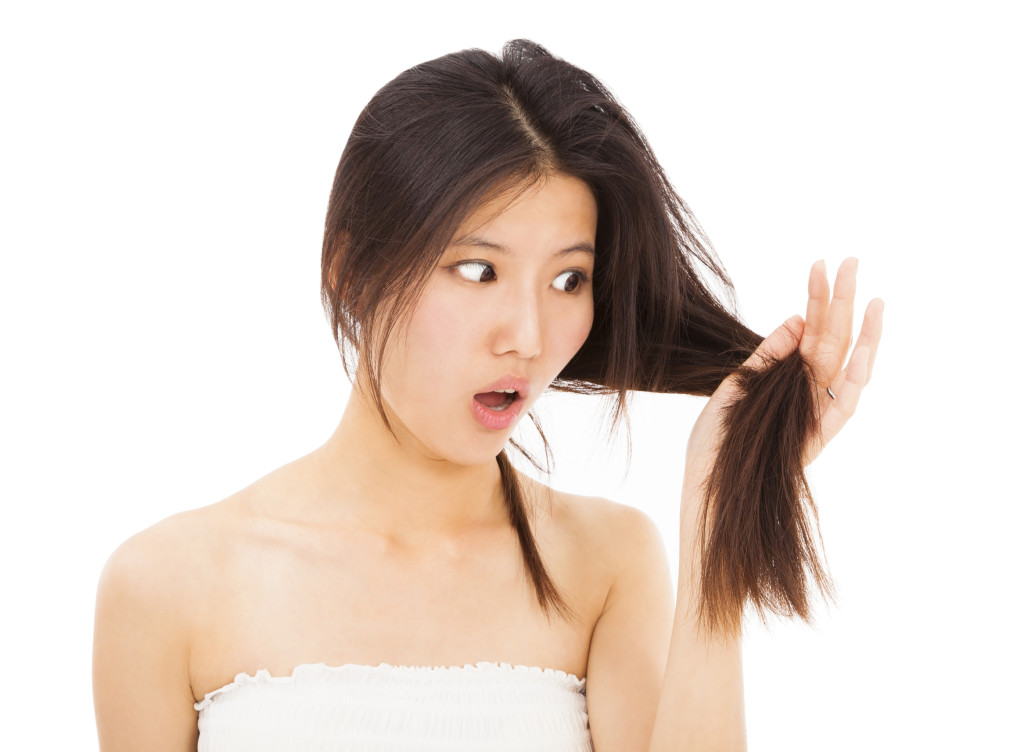
They spend a fortune making sure their hair look perfect; from wigs to hair extensions to appointments with only the best hairdressers in the world.
Sometimes you’ll look at a celeb and say “Damn, her hair looks good,” well, that may be because it’s FAKE. That’s right, fake as in not theirs. Rihanna had cropped raven hair at the MTV VMAs. A few months later, she was spotted sporting long, lustrous caramel locks. You think she used Miracle-Gro on that? The secret to her sudden length lies in hair extensions, and more stars are using them than you think. Vanessa Hudgens, Halle Berry and Jessica Simpson, just to name a few.
Piny Benzaken, the famous Beverly Hills wig and extension maker, can charge up to $4,500 for a session. He has been quoted as saying, “It’s so expensive, now it’s status to have them. It means you can afford to spend that money.”
Here’s another important point: constant hair changes can cause major damage!
Some celebs would probably love to take a break from all that processing, but they just don’t have a choice like we do. You can’t be in the entertainment business without having eye-catching and trendsetting hairstyles practically all the time. Celebrities are constantly changing their hairdos and hair colors partly because it makes sure they get more media attention. The attention a celebrity receives from these extreme hairstyles begins to wane after few weeks or months, and then it’s on to the next style to coincide with their next album or film release.
Take Anne Hathaway for example. The actress sported a chic pixie cut this year for her Oscar-award winning role in the film adaptation of Les Miserables. First it was brunette, then she decided to bleached her hair platinum blonde for a punk-rock themed event at the Met Ball in May. Three weeks later, she went back to her brunette roots. These changes were splashed all over the tabloids, but if you think this coloring spree doesn’t spell hair damage, think again!
Naomi Campbell was seen sporting bald patches, probably because of years of wearing hair extensions. Even Taylor Swift has been seen with noticeably thinner hair lately. And I’d hate to see what Katy Perry’s natural hair looks like after all that double-processing, and under all of those wigs and without hair extensions.
Lastly, copying celeb hair trends means shedding major bucks.
Want perfectly wavy hair like Kate Middleton? According to US Weekly, she spends $75 three times a week on blowouts alone. That adds up to about $11,700 a year!
What about J-Lo’s luscious locks? She pays $400 for a haircut and $350 for highlights at the exclusive Oribe Salon, which also caters to supermodel Naomi Campbell.
Kim Kardashian gets her hair extensions fixed almost monthly, amounting to around $13,918 per year.
Rihanna, who’s hairstyles change as often as the weather, spends a whopping $2,000 PER WEEK on her personal stylist, Ursula Stephen.
Katy Perry is another celeb who is constantly switching up her hairdos. One minute it’s pastel purple, the next it’s jet-black. She pays celebrity hairstylist Rita Hazan in NYC over $300 for her color and $125 for a cut.
With all that pressure to look perfect, it’s understandable that celebrities make a big deal about their hair. Maybe instead of trying to follow their crazy roller-coaster ride of hair trends, we should be thankful that we have the permission to relax and, well, let our hair down.